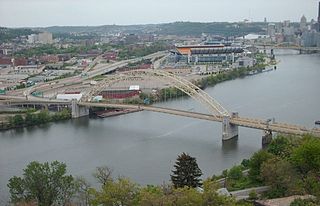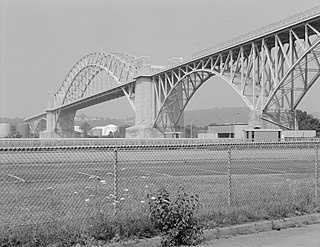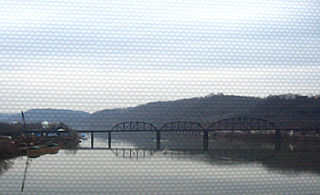
The Rockville Bridge is the longest stone masonry arch railroad viaduct ever built, at 3,820 feet (1,160 m). It has 48 70-foot spans.

The Three Sisters are three similar self-anchored suspension bridges spanning the Allegheny River in downtown Pittsburgh, Pennsylvania at 6th, 7th, and 9th streets, generally running north–south. The bridges have been given formal names to honor important Pittsburgh residents:

The Roberto Clemente Bridge, also known as the Sixth Street Bridge, spans the Allegheny River in downtown Pittsburgh, Pennsylvania, United States.

The Smithfield Street Bridge is a lenticular truss bridge crossing the Monongahela River in Pittsburgh, Pennsylvania, USA.

The Coraopolis Bridge[1] is a girder bridge over the back channel of the Ohio River connecting Grand Avenue on Neville Island to Ferree Street in Coraopolis, Pennsylvania. It opened in 1995 to replace a structure of historic significance. The original Pratt/Bowstring/Pennsylvania[2] through truss spans, designed by Theodore Cooper, were formerly the (third) Sixth Street Bridge, spanning the Allegheny River, in downtown Pittsburgh, and were built in 1892 by the Union Bridge Company. They were floated downstream by the Foundation Company in 1927 rather than being demolished when the bridge was removed to enable construction of the present (fourth) Three Sisters (Pittsburgh) Sixth Street Self-anchored suspension bridge. However, by the late 1980s, the old bridge could no longer support traffic volumes and was replaced by a newer structure.

The Philadelphia & Reading Railroad Bridge carries Norfolk Southern rail lines across the Susquehanna River between Lemoyne, Pennsylvania and Harrisburg, Pennsylvania. Some of its concrete piers encase stone masonry piers from an earlier truss bridge on this site, completed in 1891 by the Philadelphia, Harrisburg and Pittsburgh Railroad, which was then acquired by the Philadelphia and Reading Railroad to connect its Harrisburg and Lurgan lines. The current structure was constructed from 1920 to 1924 by replacing the trusses with concrete arches one track at a time. The bridge has fifty-one concrete arches, three more than the nearby Rockville Bridge.

The Hot Metal Bridge is a truss bridge in Pittsburgh, Pennsylvania, that crosses the Monongahela River. The bridge consists of two parallel spans on a single set of piers: the former Monongahela Connecting Railroad Bridge, built in 1887, on the upstream side and the former Hot Metal Bridge, built in 1900, on the downstream side. The Monongahela Connecting Railroad Bridge carried conventional railroad traffic, while the Hot Metal Bridge connected parts of the J&L Steel mill, carrying crucibles of molten iron from the blast furnaces in ladle transfer cars to the open hearth furnaces on the opposite bank to be converted to steel. During World War II 15% of America's steel making capacity crossed over the Hot Metal Bridge, up to 180 tons per hour. The upstream span was converted to road use after a $14.6 million restoration, and opened by Mayor Tom Murphy with a ceremony honoring former steel workers on June 23, 2000. The bridge connects 2nd Avenue at the Pittsburgh Technology Center in South Oakland with Hot Metal Street in the South Side. The downstream span reopened for pedestrian and bicycle use in late 2007 after two years of work. The Great Allegheny Passage hiker/biker trail passes over this bridge as it approaches Pittsburgh's Golden Triangle area.

The Fort Wayne Railroad Bridge, listed as the Pennsylvania Railroad Bridge on the National Register of Historic Places, is a double-deck steel truss railroad bridge spanning the Allegheny River in Pittsburgh, Pennsylvania.

The West End Bridge is a steel tied-arch bridge over the Ohio River in Pittsburgh, Pennsylvania, approximately 1 mile (1.6 km) below the confluence of the Allegheny and Monongahela Rivers. It connects the West End to the Chateau neighborhood on the North Side of Pittsburgh.

The Rachel Carson Bridge, also known as the Ninth Street Bridge, spans the Allegheny River in Downtown Pittsburgh, Pennsylvania in the United States.

The McKees Rocks Bridge is a steel trussed through arch bridge which carries the Blue Belt, Pittsburgh's innermost beltline, across the Ohio River at Brighton Heights and McKees Rocks, Pennsylvania, connecting Pennsylvania Route 65 with Pennsylvania Route 51, west of the city.

The Ohio Connecting Railroad Bridge is a steel bridge which crosses the Ohio River at Brunot's Island at the west end of Pittsburgh, Pennsylvania, United States. It consists of two major through truss spans over the main and back channels of the river, of 508 feet (155 m) and 406 feet (124 m) respectively, with deck truss approaches.

The West Philadelphia Elevated, also known as the High Line or Philadelphia High Line, is a railroad viaduct in the western part of Philadelphia, Pennsylvania. Now part of the Harrisburg Subdivision of CSX Transportation, the viaduct was built in 1903 by the Pennsylvania Railroad (PRR) to allow through freight trains to bypass rail yard, industrial sidings, and a passenger station.

The Wilmington Rail Viaduct is a series of fills and bridges, about 4 miles (6.4 km) long, that carries the Northeast Corridor through the city of Wilmington, Delaware, above street level. Constructed between 1902 and 1908, the structure consists principally of fills supported by heavy stone retaining walls, punctuated with plate girder bridges over streets, and augmented by a few sections of brick arch viaduct. Its construction is typical of the Pennsylvania Railroad's architectural practices at the time, and the viaduct has been documented by the Historic American Engineering Record and listed on the National Register of Historic Places. Built by the Pennsylvania Railroad (PRR) as part of a series of grade crossing eliminations along the Northeast Corridor, the elevation of the rail line necessitated several other changes to rail infrastructure in Wilmington, including the construction of the Wilmington Shops at the east end of the viaduct, and the construction of the Wilmington Station and adjacent Pennsylvania Railroad Office Building along the elevated right-of-way.

The 30th Street Bridge is a girder bridge that carries vehicular traffic across the Allegheny River between the Pittsburgh neighborhoods of Troy Hill and Herrs Island. This is the fourth bridge that has stood on this site. A wooden 19th Century bridge was washed away during an 1882 flood. This was replaced by an arch bridge that spanned the entire width of the Allegheny River; after a 1921 fire destroyed the span across the main channel, the 31st Street Bridge was constructed as a replacement, and this bridge was again relegated to taking traffic to Herrs Island. A 1939 truss bridge then stood on this site, and it was replaced by the current structure as part of the redevelopment of the island to feature condominiums and a business park instead of warehouses and stockyards.

The Washington Crossing Bridge, commonly known as the Fortieth Street Bridge, is an arch bridge that carries vehicular traffic across the Allegheny River between the Pittsburgh neighborhood of Lawrenceville and the suburb of Millvale. The bridge is decorated with the seals representing the original 13 colonies of the US and that of Allegheny county.

The Brilliant Branch Railroad Bridge is a truss bridge that carries Allegheny Valley Railroad's Brilliant Branch across the Allegheny River between the Pittsburgh neighborhood of Highland Park and the borough of Aspinwall, Pennsylvania.

The Bessemer & Lake Erie Railroad Bridge is a truss bridge that carries the Canadian National Railway's Bessemer and Lake Erie Railroad division across the Allegheny River between the Pittsburgh suburbs of Plum and Harmar Township, Pennsylvania. In 1897, a single-track trestle and viaduct was built on this site; in 1918, the original piers were doubled in width, the current double-tracked structure built alongside, and then slid into place. The original north trestle approach was buried in slag dumped from an adjacent temporary filling trestle.

The Philadelphia and Reading Railroad, Bridge at West Falls is a stone and iron plate girder bridge that is located in Philadelphia, Pennsylvania. It carries two CSX Trenton Subdivision tracks over Kelly Drive, Schuylkill River, and Martin Luther King Jr. Drive.

The Point Bridge was a steel cantilever truss bridge that spanned the Monongahela River in Pittsburgh, Pennsylvania.























